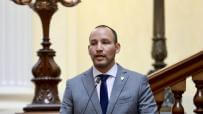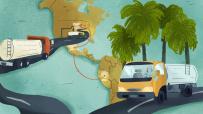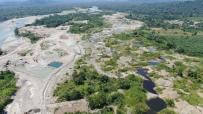
There are traces of illegal timber trafficking all over Colombia. Along the Atrato and Putumayo rivers in the heart of the Colombian Amazon barges often drag trees uprooted from the protected Amazon and the Darién rainforests, while heavy vehicles use the main highways and minor roads to transport logs and always evade the controls set by environmental authorities. Much of this harvested timber goes to sawmills and warehouses in the major cities. Without realizing it, many citizens buy these products for their living rooms and bedrooms, unaware of their illegal origin, and thus become part of the chain that is destroying the country's forests.
Timber trafficking is a multi-million dollar business. Its devastating force targets the greatest jewels of diversity: the most valuable and scarce tree species. Selective logging devastates particular ecosystems and extinguishes specific types of flora. According to calculations by the Institute of Hydrology, Meteorology and Environmental Studies (IDEAM), illegal logging in Colombia causes 10% of all deforestation.
An atypical case
April is a bad month for businesses in the Bogota’s neighborhood of 12 de Octubre, famous for the fine wood furniture sold here. The constant rain makes it difficult to promote the products. Jorge Moreno is sitting inside his store which measures just three square meters. “Business is not good,” he says. “I buy a pine armchair for COP$45,000 (US$15) and I sell it for COP$70,000 (US$23). With the difference I have to eat and pay the shop rent, which costs COP$1,000,000 (US$332). With all these environmental laws, there is less and less timber being extracted and sold.”
Like Jorge, most of the furniture merchants in the Colombian capital care little about the origin of the timber. “It probably comes from Caquetá or from Chocó. We recently received a lot of timber from Chile,” says another merchant. The differences are remarkable: “A block of cedar from here is worth COL$180,000 (US$60) and I can use it to make a bed head which I will sell for COP600,000 (US$200). But with a block of Chilean pine that costs me COP$90,000 (US$30), I do the same and sell it for COP200,000 (US$66). It is already dry and has no fungi, so people buy more.”

In this region of the Amazon, wood moves through rivers, barges, and trucks.
Photo: Danilo Canguçu / SEMANA
Colombia’s timber figures differ from other Latin American countries. Since 2014 the country has imported three times as much timber as it uses and exports. Venezuela, which has no forestry industry and lacks the strict environmental requirements demanded by markets such as the European Union, used to be one of the main markets. Anything could pass across the border: wet timber, fine species, and other products. However, the neighboring country’s economic crisis has hit this Colombian industry hard. In 2016 exports fell to US$30 million.
A few years ago that figure was US$82 million and Venezuela represented 41% of the market. “Without them everything is on hold,” says Alejandra Ospitia, Director of FEDEMADERAS (National Federation of Timber Industries), an industry association that brings together a large number of the country's loggers.
Figures from the National Administrative Department of Statistics (DANE) indicate that Colombia is failing to fully exploit its forestry potential. Only 644,000 hectares are sown of the more than 24 million hectares suitable for the timber plantations. The solution to meet domestic demand (about 5.3 million cubic meters of timber per year) has been to open the door to Chilean and Brazilian timber. According to the government, these countries together provide 35% of local consumption.
Much of the illegal timber that is extracted inside Colombia is laundered at some point in the commercial chain.
Although the authorities point to the reliance on legitimate timber imports, an illegal market also exists for species trafficked into the country. Indeed, according to the Ministry of the Environment, a startling 47% of timber sold in Colombia is illegal. Each year 2.5 million cubic meters of illegal timber is traded. Thousands of logs evade the weak controls of the authorities, travel by river and land from the jungle, and end up in the hands of furniture sellers.
The value of these transactions is high. Experts have compared the estimated figures of illegal trafficking with the commercial price of timber to conclude that the business can represent around US$750 million per year. That is almost one third of the value that the National Planning Department estimates for the country’s drug trade. Much of the illegal timber that is extracted inside Colombia is laundered at some point in the commercial chain.
All begins in the heart of the forest
Ignacio* is a logger from the Caquetá River. He extracts “fine sticks” from indigenous land in the Amazon region. Ignacio works for a patrón (boss), who obtains licenses to exploit timber from Corpoamazonia, the environmental authority responsible for protecting the forests in the area.
A license authorizes the felling of trees and specifies the areas of the forest where it can occur. The document certifies that the activity will not destroy the ecosystem. However, there is a catch: often the logging actually takes place in a protected area of the forest where it is more convenient for the logger, rather than in an area that has been authorized. So, just as in Peru and Bolivia, these forest exploitation permits end up being used to launder illegally extracted timber from unauthorized forests.
Often the logging actually takes place in a protected area of the forest where it is more convenient for the logger, rather than in an area that has been authorized.
This is acknowledged by Mario Barón, Director of Corpoamazonia: “A percentage of the logged timber is not extracted from the authorized site.” The environmental authority’s jurisdiction includes the southern Colombian departments of Amazonas, Caquetá, and Putumayo. These extend over 223,000 square[d1] kilometers, a land mass equivalent to the size of Ecuador. According to Barón, just 30 forestry officers control this vast area of dense forests and powerful rivers. There is only one possible conclusion: too much work left in the hands of too few.
On a trip down the Putumayo River one becomes very aware of something all Colombians already know only too well. The lack of controls has seen the Amazon region became the country’s second principal source of illegal timber exploitation. Barges loaded with trafficked wood sail along this large tributary which marks the border with Ecuador and Peru. Trunks can also be seen floating in the water.

The zones bordering the rivers are prone to deforestation.
Photo: Danilo Canguçu / SEMANA
According to the Institute of Hydrology, Meteorology and Environmental Studies (IDEAM), the municipalities of Puerto Guzmán and Puerto Leguízamo, both traversed by the Putumayo River, are among Colombia’s 10 most deforested local government areas. The information indicates that the timber taken from here ends up in large cities, such as Medellín and Bogotá, or smaller centers along the way, such as Pereira and Neiva.
The other principal illegal timber trafficking site is Chocó, a department whose rainforests form one of the world’s most biodiverse regions. The loggers use the mighty Atrato River. Here, logging is synonymous with deforestation. Critical points exist between the source of river in El Carmen on the Western Mountain Range and its mouth in the Caribbean Sea. It passes through Riosucio and Unguía, located on the border with Panama in the heart of the Darién Gap. Respectively, these are the second and fourth most deforested areas in the country: in 2016 alone a total of 18,000 hectares of forest were razed.
The route of timber through this region is long and winding. From Riosucio, Bajirá and high and middle Atrato, the illegal cargo is transported to Turbo (Antioquia) and from there is distributed to the capitals of the Coffee Triangle. The timber extracted from Darién ends up in shipments at ports along the Pacific and from there is transported throughout the country.
Who is behind this activity? It is difficult to know. But Miguel Pacheco, a WWF Peruvian forestry engineer who has been working in the Colombian Amazon for a decade, believes that the illegal trafficking is probably in the hands of small gangs. They even log trees inside the Los Katios National Natural Park, an area of 72,000 hectares located in Darién that is a UNESCO-declared World Heritage Site.
The timber traffickers probe these deepest and darkest forests to obtain precious and scarce species such as oak, cedar, and mahogany. Entering is easy. All it takes is a simple trick played on the authorities.
The papers that launder the timber
Police checkpoints are dotted along the road from Mocoa to Puerto Garzón, in Putumayo. Heavy vehicles laden with logs are often stopped to check that the papers are in order. On this occasion some uniformed officers flag down a truck carrying a full of timber. They request the documents that certify the legality of the load, read through them, and then allow the drive to continue on his way. A few minutes later, the officer in charge of the operation confesses that he is unable to differentiate between the types of species and has no contact with any environmental authority. The permit stated the driver was transporting sapán timber species and the officer had no option other than to believe it.
This permit—known as the Transportation Handbook—is required in order to cut and transport timber in Colombia. It is issued by the regional environmental authority following a study of the forest. The document certifies that the timber comes from authorized forests and that its exploitation does not damage the ecosystem. It indicates the volume and species to be extracted, the company or individual responsible for the, logging, the origin and destination of the timber, and how long the transport process will take. Without the document, the authorities can to confiscate the cargo.
In the last two years they have seized an amount that may seem considerable, but that is in fact insignificant: 64,000 cubic meters. That is equivalent to roughly 1,790 loaded trucks.
Although the Transport Handbook has been the tool used by Colombian authorities for 25 years, even the Ministry of Environment recognizes that it has not achieved the expected results. There are many ways to falsify this documentation.
Based on his own experience, Miguel Pacheco has been able to identify how the subterfuge works. Normally, he explains, the merchants do not even wait for a forest exploitation permit. Instead, they contact producers already in possession of papers approved to transport a certain quantity of timber and then use these a kind of blank cheque to justify the volume they actually log in the protected forests.
“We know there are sites that sell these permits in Puerto Leguízamo (Putumayo) and when they arrive at the checkpoint in Puerto Asís, the timber is already legalized. The permit may say '20 blocks of achapo’ but they actually have 50 of cedar. And since there is no scale to weigh the truck, these things happen,” explains Pacheco.
The difficulties generated by this problem can be summarized in a story told by Yarina Mesa, the legal representative of Madera Masecas, a warehouse located in 12 de Octubre in Bogota. With one of the permits in hand, she claims that although the document states that the carrier loaded 77 cubic meters of timber, she received only 33. The doubts remain: the driver could have used the same document to make additional sales, or several trucks could have carried the same paperwork to justify their loads.
Although the investigations are still at a preliminary stage, some of the clues point to international tentacles in the illegal traffic of wood. “There is a route between Colombia and Panama for the trafficking of persons and illegal gold that could also be used to trade timber,” says Luis Gilberto Murillo, the former Minister of Environment. He believes this phenomenon is also repeated elsewhere on the Pacific. “There has been illegal trafficking of timber on the border with Peru,” he warns.
The investigations are only just beginning, but, for now, the figures indicate that the illegal timber continues to primarily supply the Colombian domestic market. And as long as the industry’s potential is not being exploited in a sustainable manner, the criminals will continue to enter biodiverse forests to illegally log species for just a few pesos. Even more so now, with the signing of the peace agreement between the Government and the FARC, whose 2016 disarmament began gradually but coincided with a surge of 44% in deforestation. The guerrillas have left the forests. But other criminal organizations, attracted by the profits from illegal timber trafficking, are now invading them.
[d1]La versión en castellano no señala que son km2, sería preciso añadir.
 Tienes reportajes guardados
Tienes reportajes guardados
















